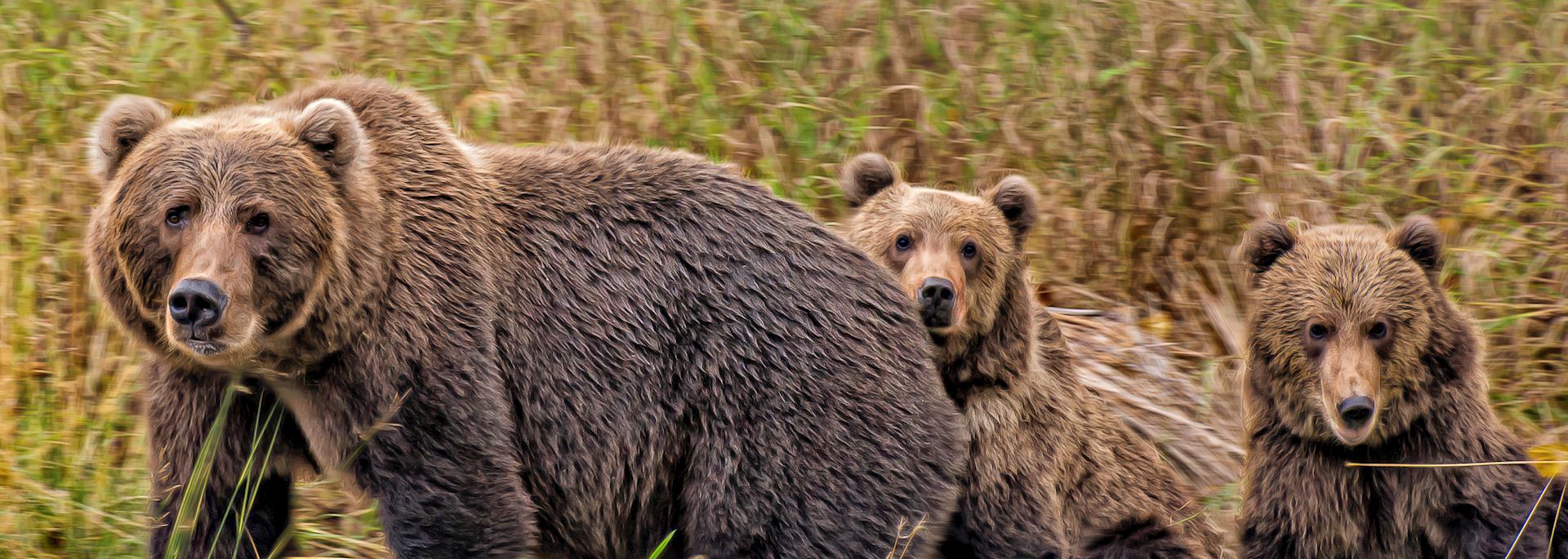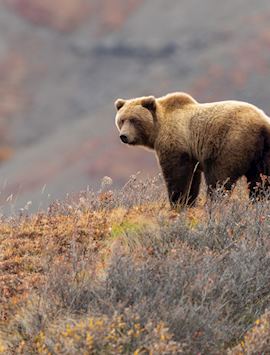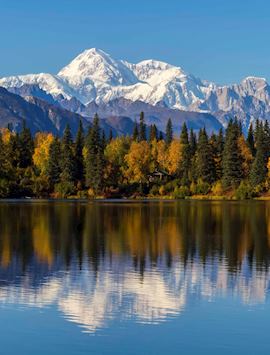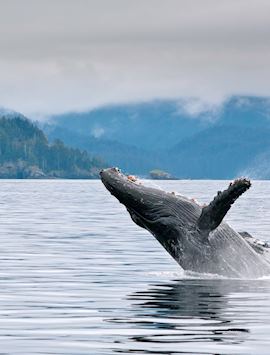More than 50,000 black bears and 35,000 grizzly bears roam the state's untamed wilderness, lumbering through berry-covered hillsides and slapping at fish in the salmon-rich rivers.
Unlike moose, you probably won't encounter bears casually by the roadside; you really have to search for them. One option is to visit Denali National Park, where your chances of seeing them, at least from a distance, improve.
To witness bears up close though, light aircraft trips to remote habitats provide the best viewing possibilities. The flight is an experience in itself, providing a wonderful opportunity to view the Alaskan wilderness. You'll fly over lakes, mountain peaks, massive ice fields, pebble beaches and tundra.
Start planning your trip to Alaska
Start thinking about your experience. These itineraries are simply suggestions for how you could enjoy some of the same experiences as our specialists. They're just for inspiration, because your trip will be created around your particular tastes.
View All Tours in AlaskaThe best places to view bears
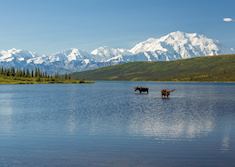
Denali National Park
Access to Denali National Park is by shuttle along the Park Road, we recommend you join a day trip from the park entrance. It’s also home to Mount Denali, North America’s highest mountain.

Katmai National Park
Katmai National Park has two of the best places in the world for bear viewing: Hallo Bay has wonderful coastal bear viewing, while Brooks Falls is the location for the famous salmon-fishing bears.
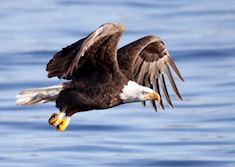
Kodiak Island
Kodiak town was once the capital of Russian Alaska, but today it is known for one reason only: it is home to the largest grizzly bears in the world.
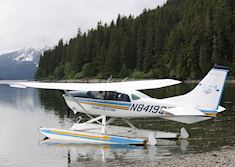
Admiralty Island
The remote wilderness area of Admiralty Island lies just 15 miles off the coast of Juneau. Locally known as "Fortress of the Bear", this large island is home to over 1,600 grizzly bears, one of the highest concentrations in the world with approximately one bear per square mile!
Grizzly bears
After polar bears grizzlies are the largest bears, with males reaching up to three m (nine feet) when standing on their hind legs, and weighing up to 550 kg (1,200 lbs). They live in the uplands of western North America, with large populations in British Columbia and Alaska.
Grizzly bears are normally solitary, active animals, but they gather in numbers alongside rivers during the salmon spawn. Every other year females produce between one and four cubs of which they are very protective. They will attack if they think they or their cubs are threatened.
Their fur ranges widely across geographic areas, from blond to deep brown or red and they have a large hump over their shoulders which is a muscle mass used to power the forelimbs in digging, while the hind legs are even more powerful. The head is large and round with a concave facial profile and they have much longer claws than most other bears. In spite of their massive size, these bears can run at speeds of up to 64 km (40 miles) per hour.
Grizzly bears are omnivorous, with their diet consisting of grasses, roots, berries and shellfish as well as moose, deer, sheep, elk and, of course, salmon. Grizzly bears readily scavenge for food, which can lead them into conflict with other species, such as wolves and humans. During early spring, as the bears emerge from their dens, elk and bison calves are actively sought. In preparation for winter, bears must double their own body weight in an autumnal feeding frenzy before going into hibernation. The dens themselves are typically located at elevations above 1,800 m (6,000 ft) on northern-facing slopes.
Where and when to see them
After hibernation grizzly bears leave their mountain dens in the spring and can be found throughout the forested regions of British Columbia, Alaska, Yukon and Northwest Territories. The bears avoid human contact if they can and consequently can prove rather elusive. The time for the best sightings is when the salmon are spawning, when bears descend from the mountains to join in the salmon feeding frenzy in the rivers. Generally speaking, salmon spawn in Alaska in July, during August in northern British Columbia and in September in southern parts of B.C. Katmai National Park and the Tongass National Forest in Alaska, and the Great Bear Rainforest in British Columbia, provide some of the finest bear viewing opportunities anywhere in the world.
Where to stay
The best bear viewing opportunities center on national parks where there are very limited accommodation options. For this reason many of the remote national park lodges are rustic with very limited facilities but are usually in utterly spectacular locations and staffed by extremely knowledgeable guides. We work with the best wilderness lodges, often private, to ensure you get the most out of your stay. Some wonderful bear watching destinations are accessible by a short light aircraft flight from larger towns, giving more accommodation options, whilst others are accessed by small comfortable yachts.
Grizzly bear fact file
- Type: Mammal.
- Population: Up to 60,000.
- Diet: Sedges, roots, berries, salmon, small and large mammals, especially elk, deer, sheep and moose.
- Reproduction: Typically a litter of 1-4 cubs is born every other year.
- Lifespan in the wild: 25-30 years.
- Size in length: 7-10 ft (2.2-3 m).
- Weight: Males 500-1,200 lbs (226-544 kg); Females 250-660 lbs (113-299 kg).
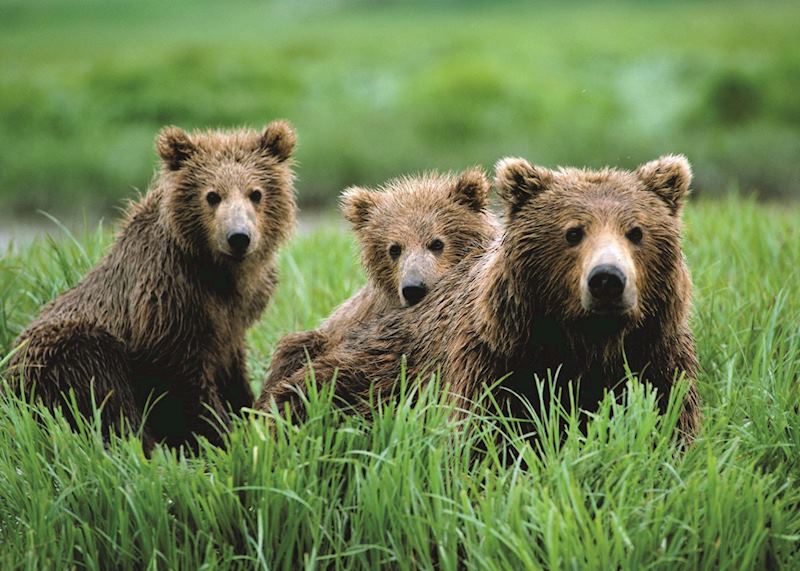
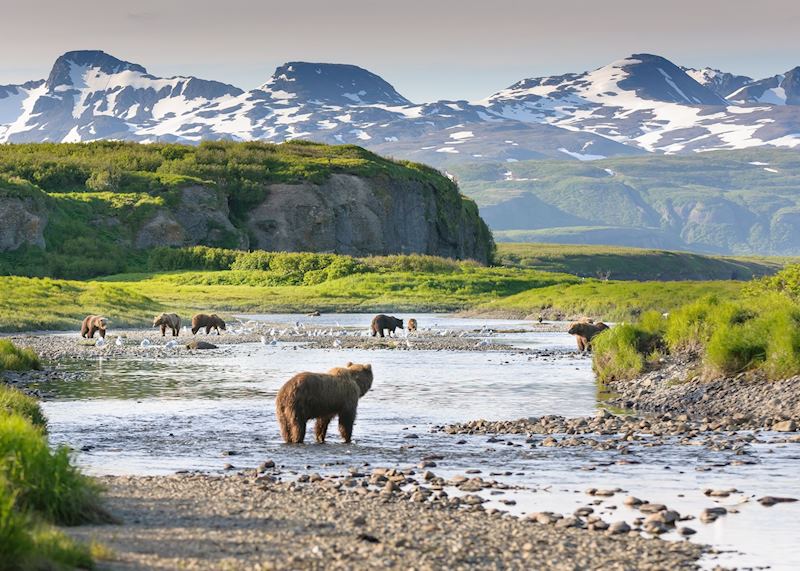

Black bears
The American Black Bear is the most common bear species in North America, living throughout the continent and in all Canadian provinces and territories apart from Prince Edward Island.
These bears can be more than two m (six feet) tall and males weigh between 115 and 365 kg (250 and 800 pounds) The adults have small eyes, rounded ears, a long snout, a large body, and a short tail and they have an excellent sense of smell. Though they generally have shaggy black hair, the coat can vary from white through to chocolate-brown, cinnamon, and blonde. Each paw has five long, strong claws used for tearing, digging, and climbing. Though less powerful than a grizzly bear, black bears are still enormously strong and they can run at speeds up to 48 km per hour (30 miles per hour) and are good swimmers. The ears of a black bear are larger and more erect than those of the grizzly bear, and it lacks a prominent shoulder hump.
Black bears are found in a wide variety of habitats and during winter they hibernate in hollowed-out dens in tree cavities, under logs or rocks, in banks, caves, or culverts. After emerging from their winter dens in spring, they seek whatever food they can including animals that have not survived the winter and new shoots of many plant species. In mountainous areas, they forage on the southerly slopes at lower elevations and move to northerly and easterly slopes at higher elevations as summer progresses. Black bears use dense cover for hiding and thermal protection, as well as for bedding. They climb trees to escape danger and use forested areas and rivers as travel corridors.
Mating is generally during summer, from mid-June to mid-August and the cubs are generally born in January or February. They are very small, about 240-300 grams (10-14 ounces), and are blind, nearly hairless, and helpless when born. The cubs become independent during their second summer.
Black bears are omnivores whose diet includes plants, nuts and berries, bees, wasps, rodents, salmon, deer fawns and moose calves. They are apex predators in North America, with the exception of areas where they coexist with the grizzly bear.
Where and when to see them
Black bears can be seen relatively easily during summer months while driving or taking a train through the less populated regions of North America. National and provincial parks in particular are perfect places for having a chance encounter with these bears, especially Banff and Jasper national parks, Algonquin Provincial Park in Ontario and the Mastigouche Wildlife Reserve in Québec. Northern Vancouver Island, interior British Columbia and Riding Mountain National Park in Manitoba are also excellent places to see them.
Black bear fact file
- Type: Mammal.
- Population: Up to 600,000 in North America.
- Diet: Sedges, roots, berries, salmon, insects, small mammals.
- Reproduction: Typically a litter of 1-3 cubs is born every other year.
- Lifespan in the wild: 20-25 years.
- Size in length: Up to 7ft (2.12 m).
- Weight: Males 250-800 lbs (365 kg); Females 90-400 lbs (40-180 kg).
